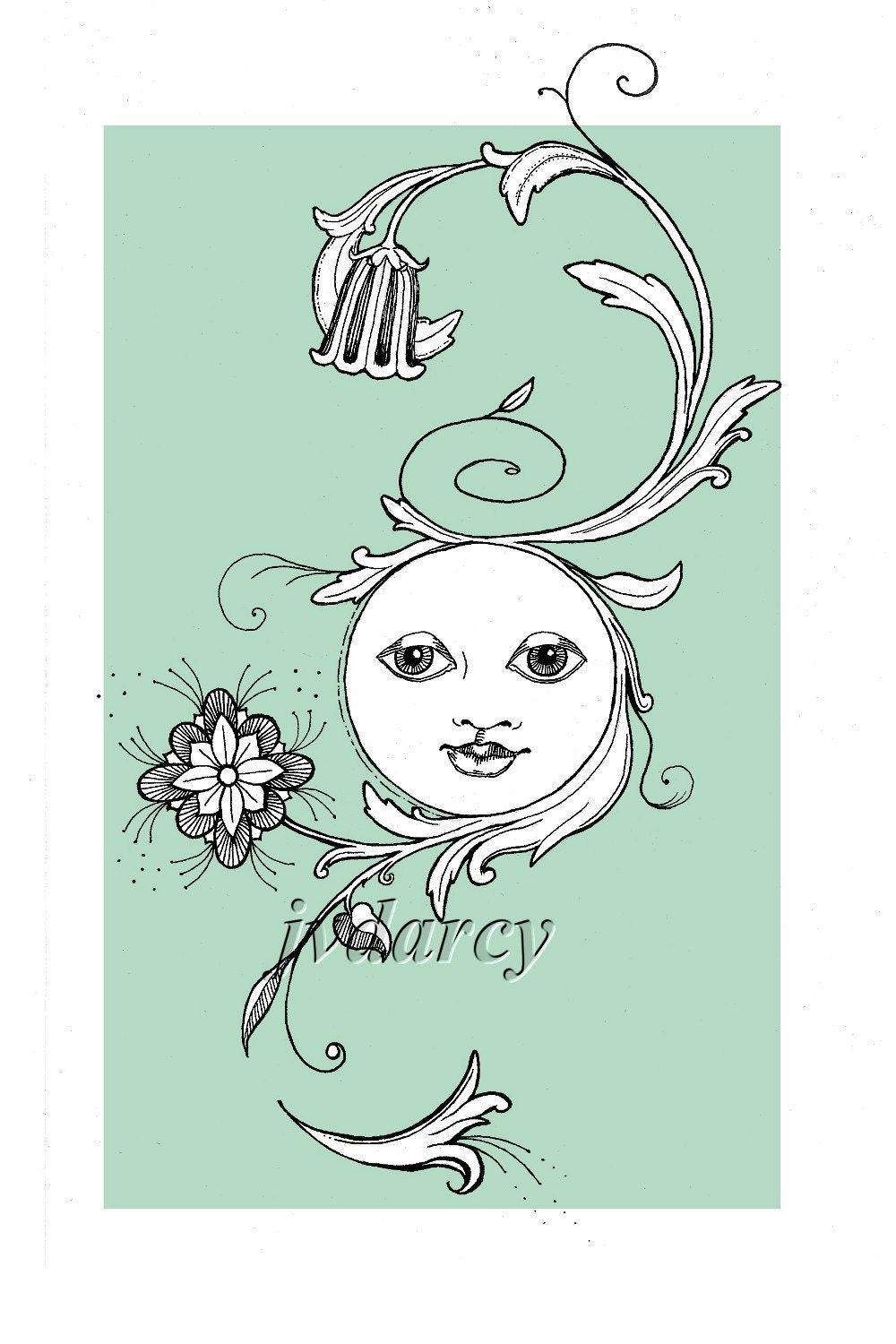 |
| Imaginary Flora, digital manipulation of old microscope photography |
Monday, April 30, 2012
Trying out Tophatter
Sunday, April 22, 2012
The Mint is Dead, Long Live the Mint
 |
| Paisley-Face in mint, available in my Etsy Shop. |
It is the destiny of mint to be crushed.
--Waverley Lewis Root
Apparently, Waverly has only crushed it, for he seems to have left out the part where the mint is more than happy to be crushed, as it knows it will simply grow back from where you have ripped it from the ground and strangle out the sturdiest of more delicate and desirable herbs. (In case you were wondering, as was I, who on earth Waverley Lewis Root was, I Wikipedia'ed him, and he was an American journalist for the Chicago Tribune and the Washington Post who wrote primarily about food. I'm sure if I could ever get any of my family or friends from Northern Virginia to read my blog, one of them would have probably known him. Alas, then I'd have to take the heat about writing a blog as the only non-professional-writer member of my family. Phhht, I say to that.)
Who knew that a gift from my daughter's elementary school teacher a dozen years ago would still be reaching out to bitch-slap my garden all these years later, despite my attempts to kill it.
Dear, sweet, Ms. Voge, the most beloved teacher a young girl (and her parents) could have, at the end of the school year, invited her entire class and their parents over to her house for a party. As a twenty-something nouveau-hippie, she grew her own veggies and herbs and raised bunnies in her vast back yard, and collected eclectic vintage and exotic furnishings for her little house. As a gift to each of her students, and unwittingly making herself Patient Zero in this city-wide, minty contagion, she gave a single, tiny mint plant to take home. Since I grew up a couple thousand miles Northeast of here, knowing how well it grows in Virginia, I took it home, expecting it to grow for a little while, at least as long as my daughter's attention-span at the time, then perish in the gruesome desert of the Southwest. Little did I know that that mint plant would spread across the area I had planted it in and send out little feeder roots to my entire back yard.
Both my son and I have gone through and ripped out any signs of mint-life to be found from under the cottonwood tree, where we originally planted it (don't get me started on what a noxious weed of a tree the cottonwood is). I dug out the tiny roots that had infiltrated the dirt plot around the tree in order to grow something--really anything--I wanted, instead.
 |
| That was a couple of weeks ago. |
Since I needed to treat the tree for disease this year, I decided to plant flowers there, since the treatment chemicals are not the sort of thing you'd want in your edibles. I gave it some yummy soil and some extra chunks from the peat pots my edible plants were in, and sowed a few marigold seeds.
 |
| Oh, come on. |
 |
| Okay, seriously. F*ck you already. |
I seem to have been able to extract all the rosemary from years past. This year I bought ONE plant of rosemary, and I planted it next to my broccoli, as was suggested by my research about Companion Gardening, and it seems to get along okay so far.
 |
| Okay, Rosemary old girl, I'M WATCHING YOU. |
So we shall see what the future holds for the battle of the
To end my tale of treachery, I'll leave you with this picture of my larger garden plot, complete with three different types of tomatoes, basil, and oregano.
Labels:
art,
cautionary tale,
companion planting,
Etsy,
gardening,
mint,
rosemary,
southwestern garden,
tomatoes,
weeds
Location:
Albuquerque, NM, USA
Friday, April 13, 2012
Companion Planting: I Sure Don't Know Much About Plants
 |
| Dandelions attract pollinating insects and promote fruit ripening. Mwah! |
When I told my husband I'd gone out and bought seeds and some seedlings to plant this year, he gave me quite an earful on all the stuff I might do wrong, and how you can't plant some plants next to each other, or else they'll try and kill each other, or plot against you in a bid for global domination, or some shit. Once I felt thoroughly schooled in what I didn't know, I figured I'd seek out some knowledge about what to plant together and what not.
As it turns out, what he was mostly talking about was a concept called Companion Planting. The principles of companion planting have to do with how different plant species can help each other in different ways, including nutrient uptake, pest control, and pollination. Some plants planted next to each other will cause both species to thrive, while other combinations of plants can be detrimental to one side or the other. Some plants repel specific pests (onions and other alliums repel aphids and slugs), so they should be planted next to other species that are vulnerable to those pests. For some reason I cannot seem to discover, you should not plant brassicas (broccoli, cauliflower, cabbages) near nightshades (tomatoes, peppers and potatoes), as they universally hate each other. Since I am planting two relatively small plots in separate sections of my yard, and not planting a zillion different things across the vast farmland of America, I was able to divide and conquer, based on plant compatibility.
Some excellent resources I found were at Wikipedia (of course!), where there is a general discussion of companion planting, as well as a rather detailed list of plant compatibility, broken down into categories and giving the specifics of each type of harm or benefit (although no one seems to have an explanation as to why broccoli and tomatoes hate each other--bad phloem, I guess).
 |
| The tension down here is palpable. Someone's about to get cut. |
So, in case you're wondering what sorts of yumminess I have planned for the growing season, here's the plan for my two planting areas. In the smaller of the two beds, I'll plant the broccoli and cauliflower, along with sage and rosemary. That bed might fit some yellow beans as well, if they ever decide to germinate. Then, all the way on the other side of the yard (are you hearing me, broccoli?) I'm planting TONS of tomatoes, along with Serrano chili peppers, basil, oregano, and flat-leaf parsley. For tomatoes, I got traditional Romas, some Super Sweet 100 cherries, and an heirloom called Black Krim. The Black Krim variety is from the Isle of Krim on the Black Sea, which I'm totally hoping is just like the land-locked desert of the Southwestern U.S.
 |
| Image from veggiegardener.com, click to read their article about the Black Krim! |
If my peas germinate, they go in that box as well, though I may have to build some sort of wall of herbs between them and the tomatoes (I can't seem to get an honest answer from any of these sites as to the compatibility of tomatoes and peas.). Oh, and apparently, I need to plant those marigold seeds I got around both planters, as they give off all sorts of bad bug mojo. I will try and keep my readers apprised of how things are going over the course of the summer, with lots of pictures of the Doberman trying to steal tomatoes off the vine and getting zapped by the electric fence.
Tell me what your favorite homegrown vegetables and fruits are! Are you planning on growing any this year?
Subscribe to:
Posts (Atom)
